8 Donkey Kick Exercises To Tone Your Glutes Naturally
Simple variations that help you achieve the right curves with toned thighs and shapely hips.
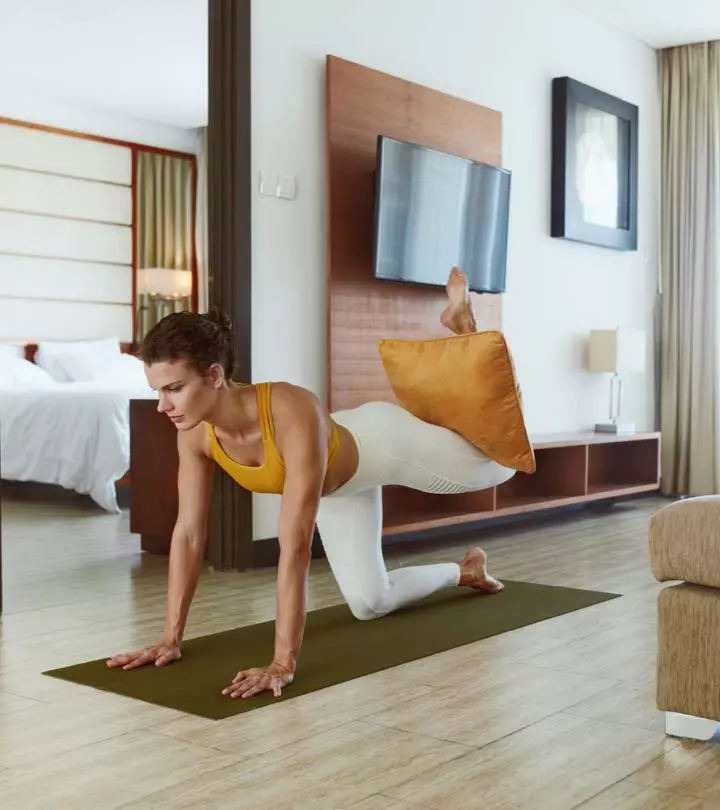
Image: ShutterStock
Donkey kick exercises are great for toning and strengthening your glutes and legs. These exercises can help you get round, firm buttocks and shapely hips. Strong glutes also support your spine and trunk, help prevent injury, and hold your upper body weight. Moreover, they make you look fab and shapely in workout leggings, high-waisted jeans, and cocktail dresses! Read on for a step-by-step guide to doing many variations of donkey kicks. You can do them at home or at the gym. Keep reading!

 Workout Blueprint: Donkey Kick Exercises
Workout Blueprint: Donkey Kick Exercises- Frequency: 3-4 times a week.
- Benefits: Strengthen the glutes and hamstrings and tone the butt.
- Equipment Needed: Yoga mat, resistance band
- Space Required: Small area
- Assistance Required: No
- Who Should Avoid: Anyone with a knee or back injury or has recently undergone surgery.
In This Article
How To Do Donkey Kicks Properly
Donkey kicks or kickbacks are a great physical activity that strengthen your glutes, work one side of your buttocks at a time, and strengthen your hamstrings. In fact, this is one of the best bodyweight hamstring exercises to include in your daily workouts.
However, maintaining proper form is crucial to working the right muscles and preventing injuries. Here’s a demonstration of how to do donkey kicks properly.
Step 1: Come to the hands and knees position: hands under the shoulders, knees under the hips, back flat, abdominals pulling in, and the shoulders pulling down. Keep the elbows right below the shoulders and look forward.
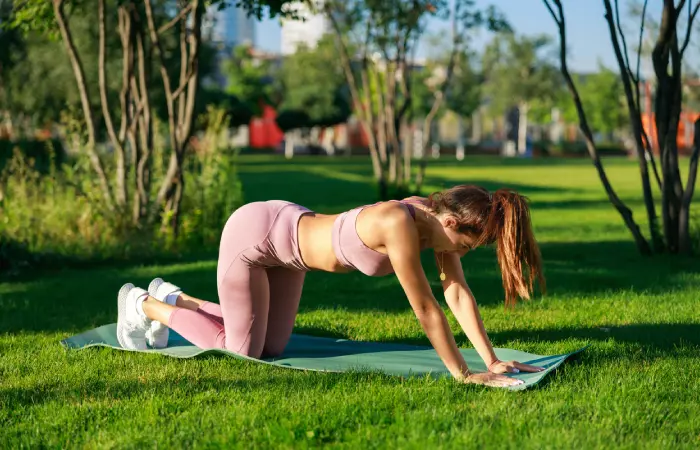
Step 2: Keeping your leg bent to 90 degrees, lift your right knee off the floor in line with your hip. This is the starting position. Do not arch your lower back.
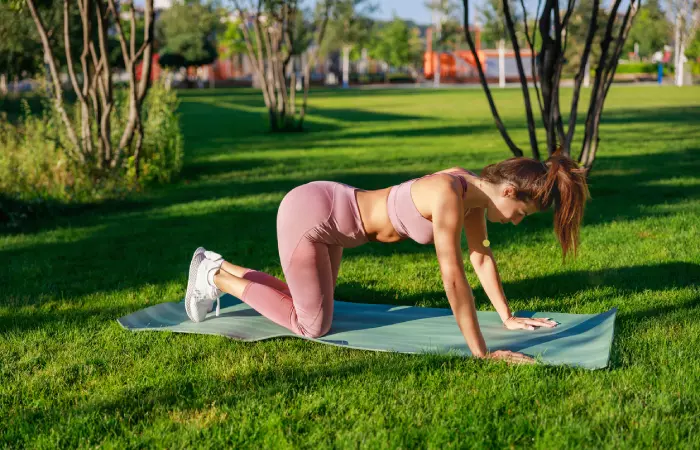
Step 3: Flex your foot and kick your right leg up towards the ceiling. Do not let your lower back arch – keep your abdominals tight and squeeze your glutes and hamstrings. Keep your lower back flat so you work your glutes and hamstrings and do not strain your lower back. Keep your shoulders down and torso still.
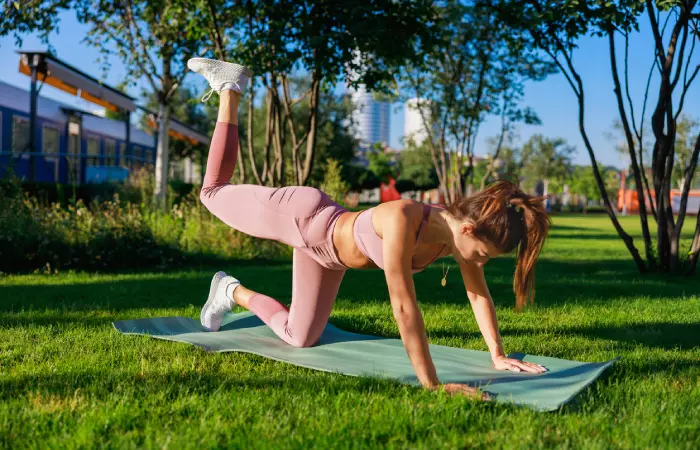
Step 4: Pause for a second, squeeze your glutes, and lower your right knee back to the starting position while keeping the rest of your body still.
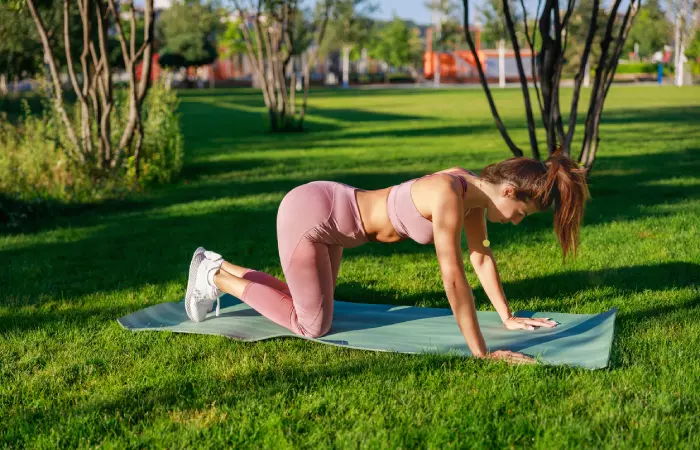
Step 5: Repeat 10 times before switching legs.
It is easy to make a few common pitfalls when performing donkey kicks, especially if you’re a beginner. Check out the next section to learn these common mistakes and ensure optimal results and prevent injuries.
Key Takeaways
- Donkey kick exercises help tone and strengthen your muscles in the hips and legs.
- These strengthen your glutes, help give a rounded full-bodied look to your hips, and reduce risk of injury (especially in your knees).
- There are a variety of donkey kick exercises that can be done either in the gym or at home based on your time and preference.
Common Mistakes To Avoid
Being aware of common errors and focusing on proper form can help you maximize the benefits of donkey kicks and achieve a stronger, more toned core. Avoid common mistakes such as:
- Do not arch your lower back as it can strain your back muscles.
- Ensure to engage your core otherwise, it would be difficult to lift your leg.
- Do not lift your leg too high as it can put unnecessary stress on your hip flexors.
Avoid these common pitfalls and maximize the benefits of donkey kicks by keeping a few beginner-friendly tips in mind. Keep reading!
Tips For Beginners
- Warm up your body with light cardio and dynamic stretches to prepare your muscles before the workout.
- After your workout, cool down with static stretches to improve flexibility and reduce muscle soreness.
- If you feel any pain, stop the exercise and rest.
- If you find the full donkey kick challenging, try a modified version by bending your knee towards your chest instead of lifting it straight up.
- Use a yoga mat or a soft surface for comfort and support during the exercise.
Apart from doing the traditional donkey kickback exercise, you can also add variations or modify them. Scroll down to learn different donkey kick variations with pictures and instructions. These are great exercises for legs and thighs.
8 Donkey Kick Variations
1. Resistance Band Donkey Kick
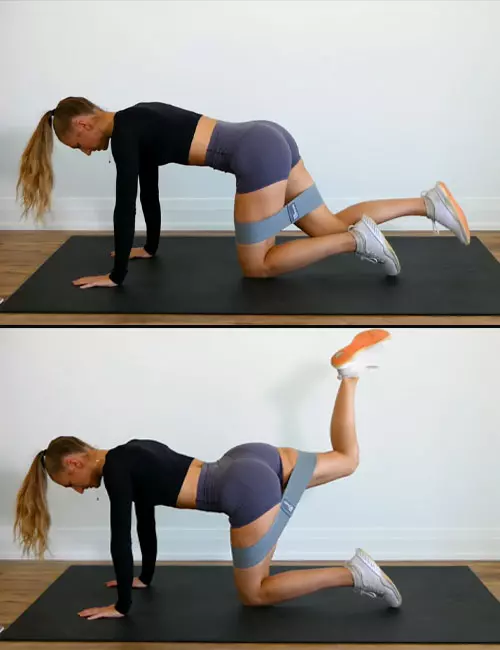
How To Do
- Place a loop resistance band right above your knees.
- Come to your hands and knees: hands under the shoulders, knees under the hips, back flat, the abdominals pulling in, and the shoulders pulling down. Get on all fours, engage your core and hips in a neutral position. Keep the elbows right below the shoulders and look forward.
- Keeping your leg bent to 90 degrees, lift your right knee off the floor in line with your hip. This is the starting position. Do not arch your lower back.
- Flex your foot and kick your right leg up towards the ceiling. Do not let your lower back arch – keep your abdominals tight and squeeze your glutes and hamstrings. Keep your lower back flat, so you work your glutes and hamstrings and do not strain your lower back. Keep your shoulders down and torso still.
- Pause for a second, squeeze your glutes, and lower your right knee back to the starting position while keeping the rest of your body still.
- Do this 10-15 times before switching legs.
 Quick Tip
Quick Tip2. Straight Leg Donkey Kicks
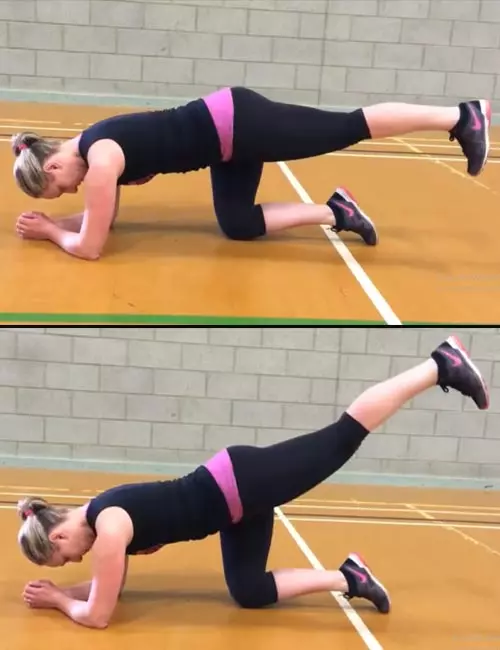
How To Do
- Come to your hands and knees: hands under shoulders, knees under hips, back flat, abdominals pulling in, and shoulders pulling down. Keep the hands right below the shoulders and look forward.
- Bend your elbows and place them directly under your shoulders.
- Engage your core, keep the elbows right below the shoulders, pull your shoulders down, lengthen your spine, and look straight in front of you.
- Extend your right leg straight behind you, with the toes touching the floor. This is the starting position.
- Lift your right leg off the floor by squeezing your glutes and hamstrings. Keep it extended and kick the leg up. Do not let your lower back arch at all. Keep your shoulders pulling down.
- Do 10-15 pulses – only pulse as high as you can without arching your lower back.
- Switch legs and repeat.
3. Band Leg Extension Donkey Kick
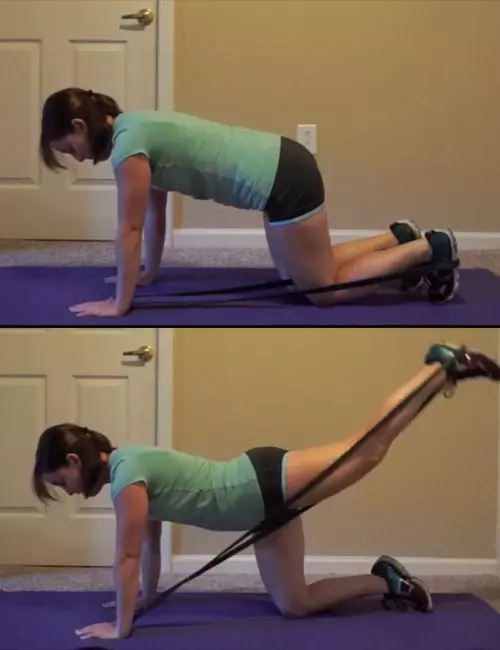
How To Do
- Hold the handles of a resistance band.
- Come to your hands and knees: hands under shoulders, knees under hips, back flat, abdominals pulling in, and shoulders pulling down.
- Wrap the resistance band around the sole of your right foot.
- Lift your right leg off the floor in line with your hip, engage your core, do not arch your lower back, and look straight in front of you. This is the starting position.
- Keeping your leg up, bend your knee to 90 degrees and kick your foot up towards the ceiling.
- Straighten your leg back to the starting position. Do not let your lower back arch to avoid placing stress on your lower back and to keep the glutes and hamstrings working.
- Do this 10 times before switching legs.
4. Standing Donkey Kickbacks

How To Do
- Place a loop resistance band around your thighs.
- Stand near a wall. Place your right hand on the wall for support and the left one on your waist.
- Keep your knees soft, weight distributed evenly on all sides of your foot , spine long, shoulders down, and core engaged. This is the starting position.
- Extend the right leg straight behind you, toes pointing down or out slightly. Kick it back without arching your lower back – pull your abdominals in tight and brace through your core. Squeeze your glute.
- Lower your leg to the starting position with control.
- Do this 10 times before switching legs.
5. Reverse Lunge Kickback
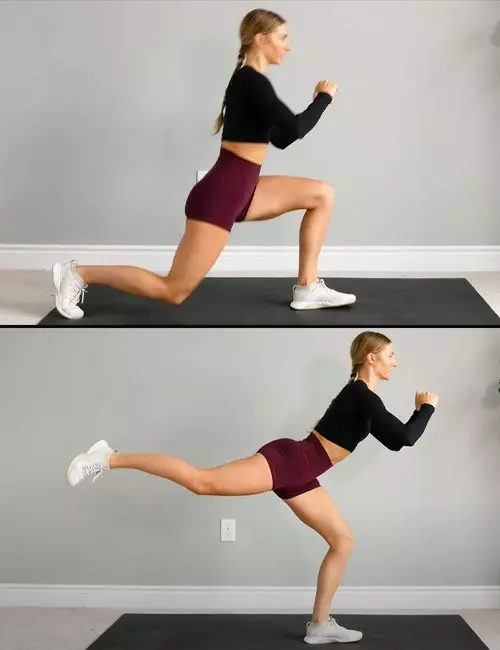
How To Do
- Stand tall with your legs shoulder-width apart, knees soft, shoulders rolled back, spine long, abdominals in, and head in line with your spine.
- Take a step back with your right leg, bend both knees, and lower your body into a reverse lunge position by bending your knees to 90-degree angles (front knee over ankle, back knee under hip). Make sure your knees track over the centers of your feet and do not roll in.
- Straighten your legs, and kick the right leg straight behind you without arching your lower back. Push into your front glute and squeeze your back glute.
- Bend your knees back down into the reverse lunge position with control.
- Do this 10 times before switching legs.
6. Donkey Kick With Leg Extension
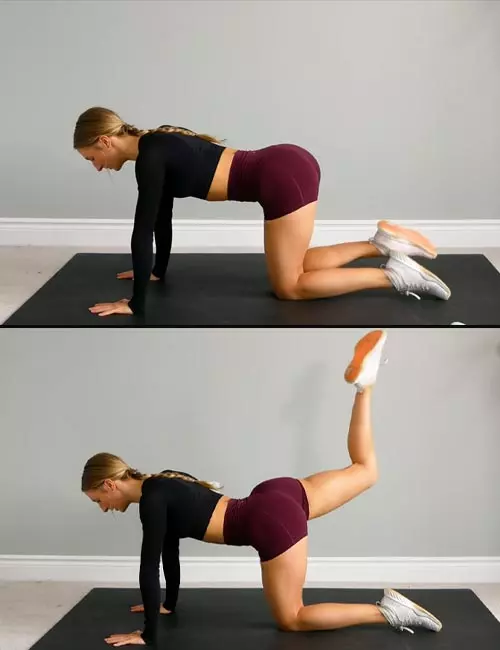
How To Do
- Come to your hands and knees: hands under shoulders, knees under hips, back flat, abdominals pulling in, and shoulders pulling down.
- Lift your right leg straight behind you in line with your hip, without arching your lower back. This is the starting position.
- Bend your right knee to 90 degrees and kick your heel up towards the ceiling.
- Pulse twice without arching your lower back.
- On the third pulse, straighten your leg in line with your hip. Do not arch your lower back or move your torso – brace your core.
- Lower your leg back down to the starting position.
- Do this 10 times before switching legs.
7. Fire Hydrant With Resistance Band
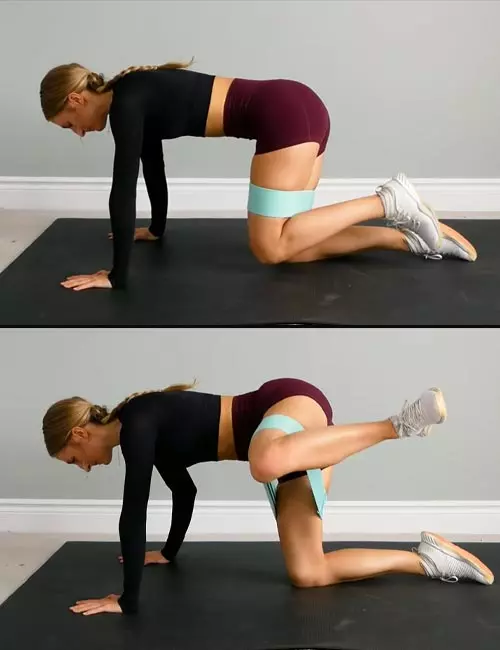
How To Do
- Wrap a loop resistance band just above your knees.
- Come to your hands and knees: hands under shoulders, knees under hips, back flat, abdominals pulling in, and shoulders pulling down.
- Lift your right leg straight off the floor in line with your hip. This is the starting position.
- Bend your knee and move your out to the side and up.
- Do not lean to the left – keep your shoulders down and bring more weight into your right hand.
- Pause for a moment and squeeze your outer hip, then bring your right leg back to the starting position behind your hip.
- Do not let your torso move, lean, or sway throughout the exercise.
- Do this 10 times before switching legs.
8. Smith Machine Donkey Kick
How To Do
- Get on all fours. Ensure your right foot’s arch is under the bar of the Smith machine, as it forms a 90-degree angle with your right knee.
- Maintain a distance of one to two feet in front of the machine. Align the bar with your body.
- Engage your glutes and hamstrings while keeping your core tight. Use these muscles to initiate the movement.
- Push the bar upwards from under your foot.
- Stop if you sense your hips rotating or your back arching.
- Once you are steady, resume, and pause briefly at the peak of the movement.
- Gently lower the bar back to the initial position.
- Do 3 to 4 sets of this exercise, with 8 to 12 reps on each leg.
These are the 8 variations of the original donkey kick workout. What are the benefits of doing so many variations of the same exercise? Let’s find out in the section below.
Benefits Of The Donkey Kick Exercise
- Helps stabilize the core
- Improves the hip’s range of motion
- Strengthens the glutes and hamstring muscles
- Tones and shapes up the butt
- Improves balance and fitness levels
Since donkey kicks mainly work out your glutes, you might be wondering if they can help you get a bigger and beautiful butt. Scroll down to find out.
Can Donkey Kicks Make The Butt Bigger?
Yes, donkey kicks are how you can get curvy! Donkey kicks and their variations are great for toning and strengthening the gluteal muscles. Doing these exercises regularly can help improve your butt’s shape and make it rounder and firmer. In other words, your butt will get a natural lift. Whether the size of your glutes will increase or not depends on how much you challenge yourself with the exercise (the more you challenge yourself, the more likely your muscles are to grow), the thickness of the resistance bands you use (thicker bands provide more resistance, which can help build muscle), and your genes.
Christine, a blogger, shares her and her husband’s decision to perform the donkey kicks as a part of their fitness challenge. They decided to do 50 donkey kicks, and she writes, “After the lunges it was the donkey kicks, remember that you can add an ankle weight or a stretch rope to make you work harder. If I start the challenge over I will have to get some add-ons to make the exercises work a little better for me. Some items are at least not too expensive to get (i).”
However, squats are considered the official exercise for shaping the butt. Is it possible that squats are better than donkey kicks for a bigger butt? Find the answer below.
 Quick Tip
Quick TipAre Squats Better Than Donkey Kicks?
Squats are great for toning and strengthening your lower body, and work both your thighs and butt. However, donkey kicks are equally important as they help stabilize the core, increase the range of motion, and isolate your glutes and hamstrings. To get a bigger butt, do a mix of squats and donkey kicks along with their variations.
Infographic: Top 3 Donkey Kick Exercises For Toning Glutes
If your focus lately has been on getting those perfectly peach-shaped glutes and firm thighs, try donkey kicks. While many lower-body exercises are effective in toning the buttocks, donkey kicks work the best. Check out the infographic below for the top 3 donkey kick exercises that you can incorporate into your workout routine.
Some thing wrong with infographic shortcode. please verify shortcode syntaxThe donkey kick exercise is a wonderful way to strengthen the glutes and get toned buttocks. But it is important to get the form right to target the right muscles, so you may take the help of a professional. If done perfectly and regularly, this exercise helps stabilize the core, enhance the hip’s range of motion, strengthen hamstrings, and improve balance apart from helping you get a bigger and more sculpted butt. If you have mastered the basic form of this exercise, you can go for the seven variations mentioned in this article for better results. You can also combine these donkey kicks with bodyweight training to create an exercise routine that works for you.
Frequently Asked Questions
Are donkey kicks good for abs?
Yes. Donkey kicks target the entire core and help tone the ab muscles and improve stability.
Are donkey kicks aerobic or anaerobic?
Donkey kicks are an aerobic glute exercise that work on your lower body. They tone your glutes and hips.
Are donkey kicks cardio?
Yes, donkey kicks are cardio. They can help improve your upper body strength and tighten your core.
Discover the right technique to do donkey kicks. Watch this video to find out what you need to change in order to do this exercise correctly and safely.
Personal Experience: Source
StyleCraze's articles are interwoven with authentic personal narratives that provide depth and resonance to our content. Below are the sources of the personal accounts referenced in this article.
i. donkey kicks- Day 16https://christinebeket.wordpress.com/tag/donkey-kicks/
Read full bio of Gabbi Berkow
Read full bio of Ravi Teja Tadimalla
Read full bio of Moksha Gandhi






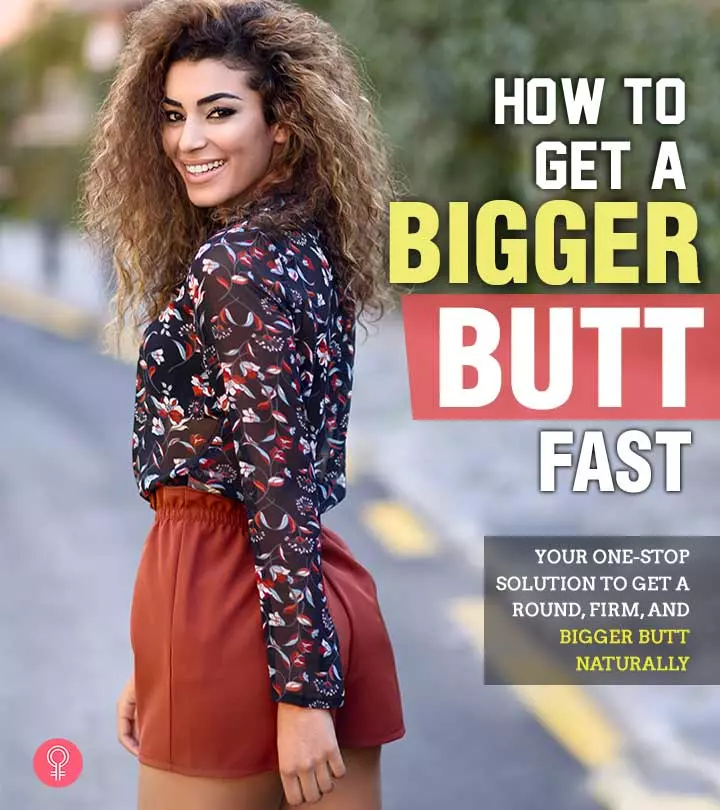


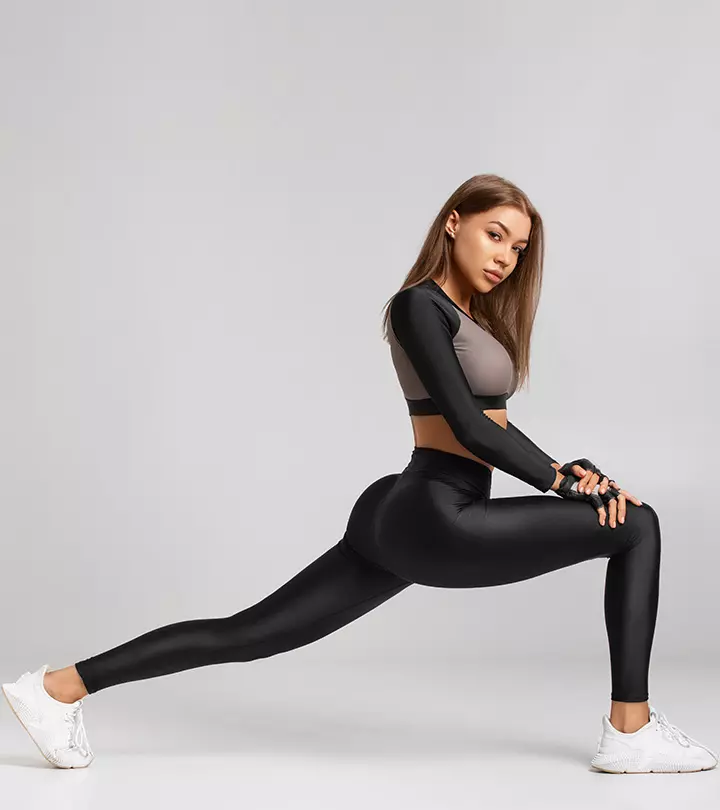
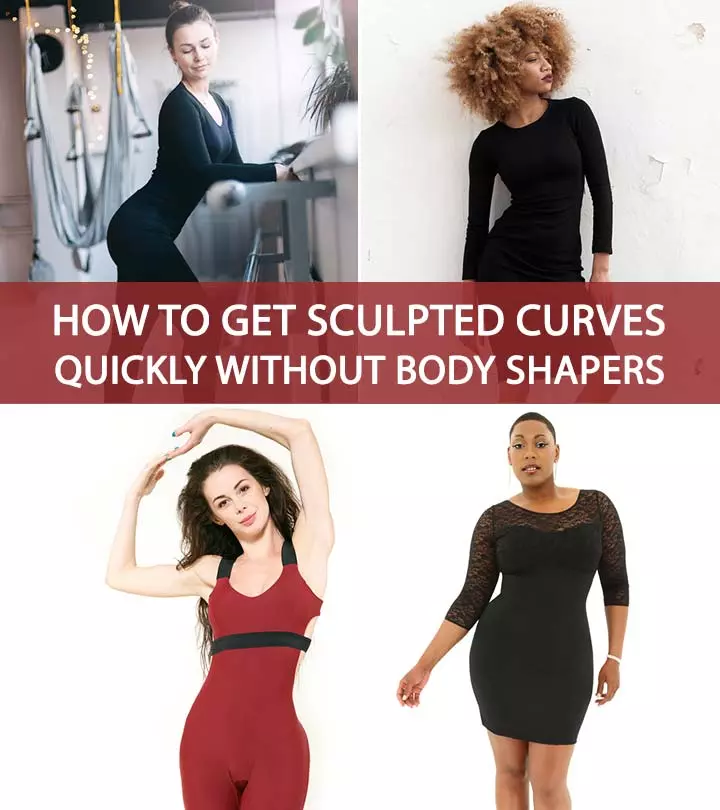


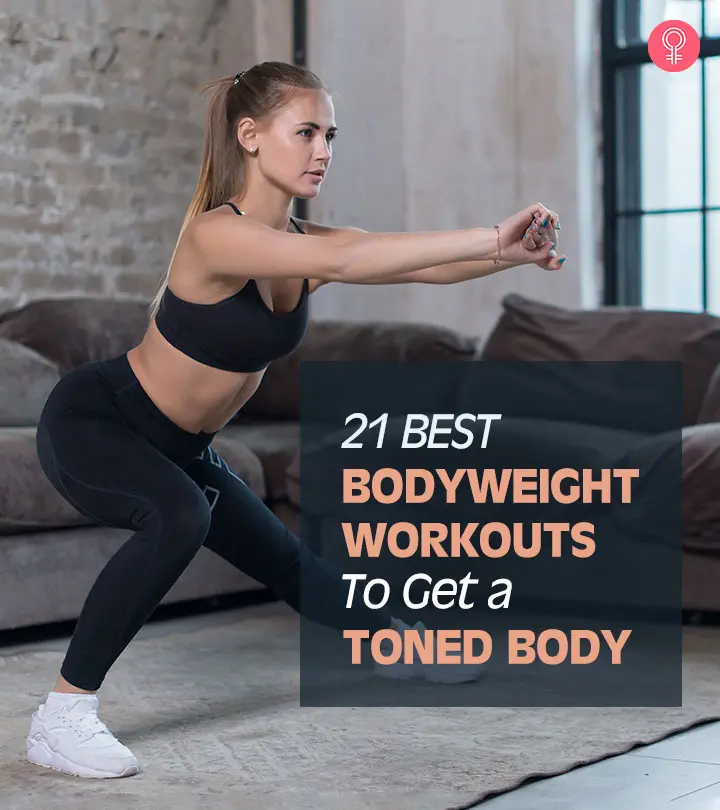
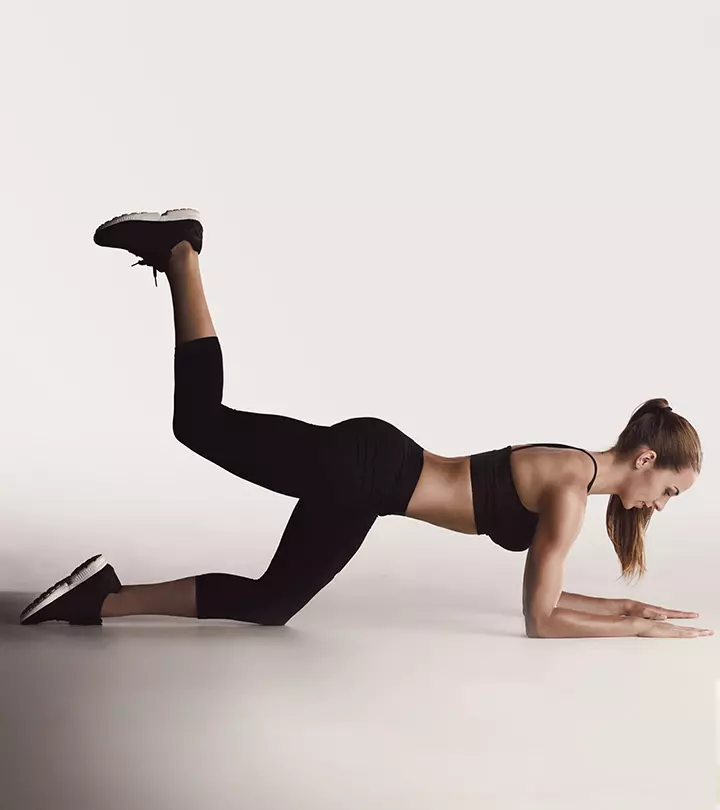



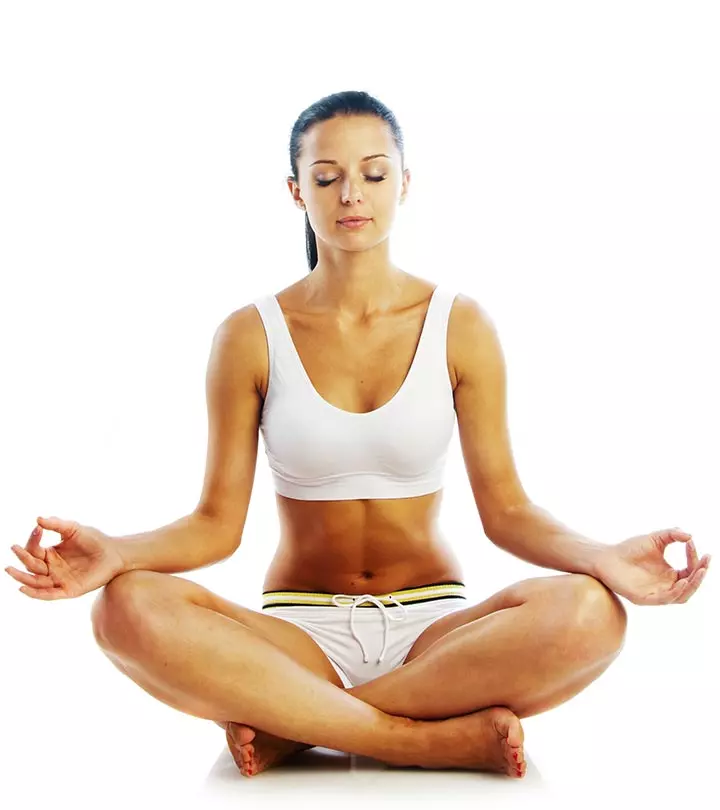

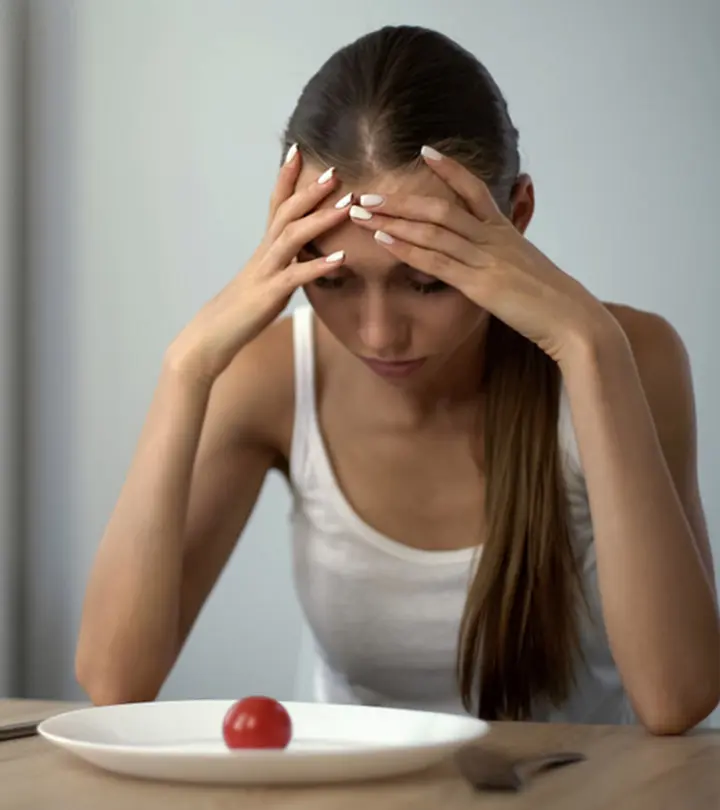
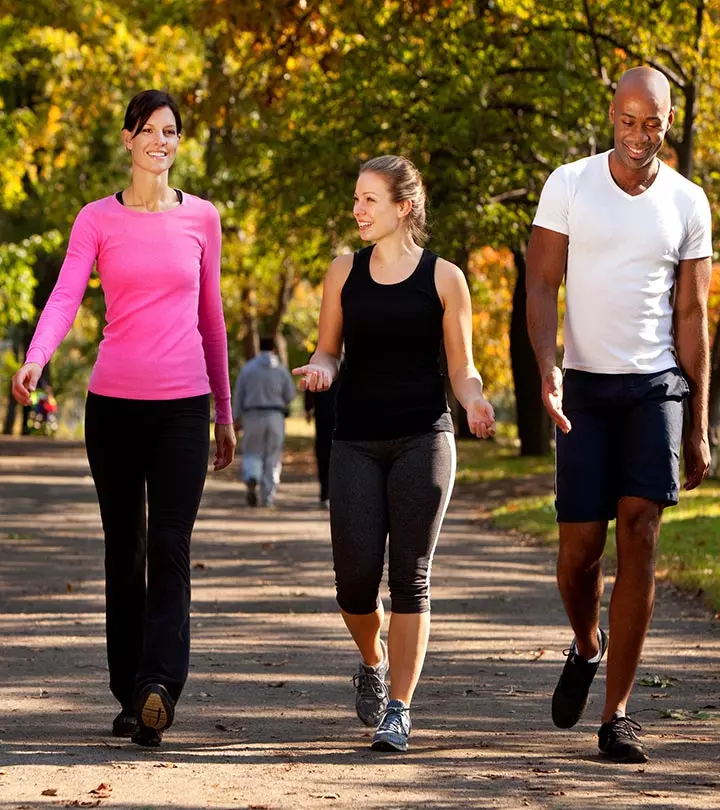


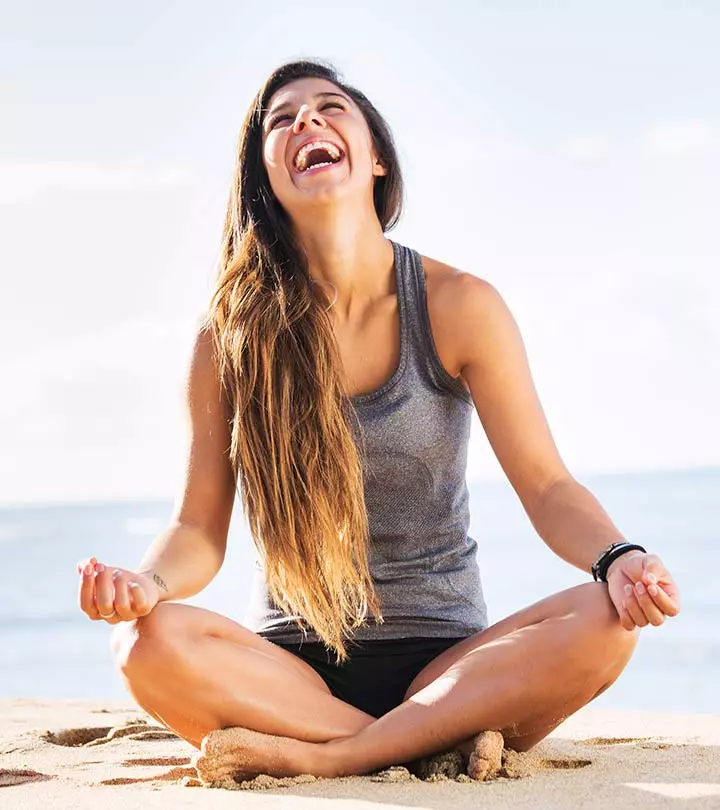
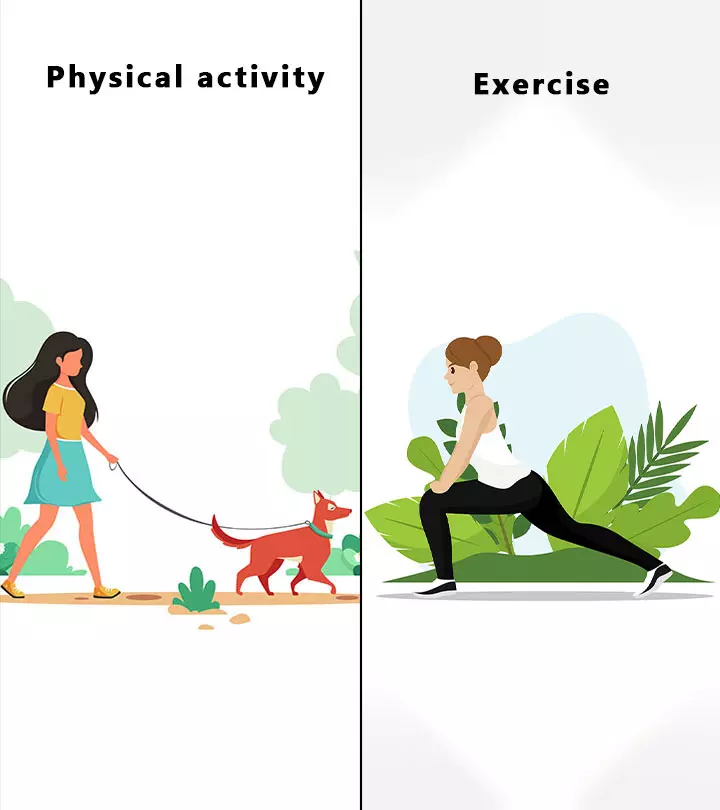
Community Experiences
Join the conversation and become a part of our empowering community! Share your stories, experiences, and insights to connect with other beauty, lifestyle, and health enthusiasts.